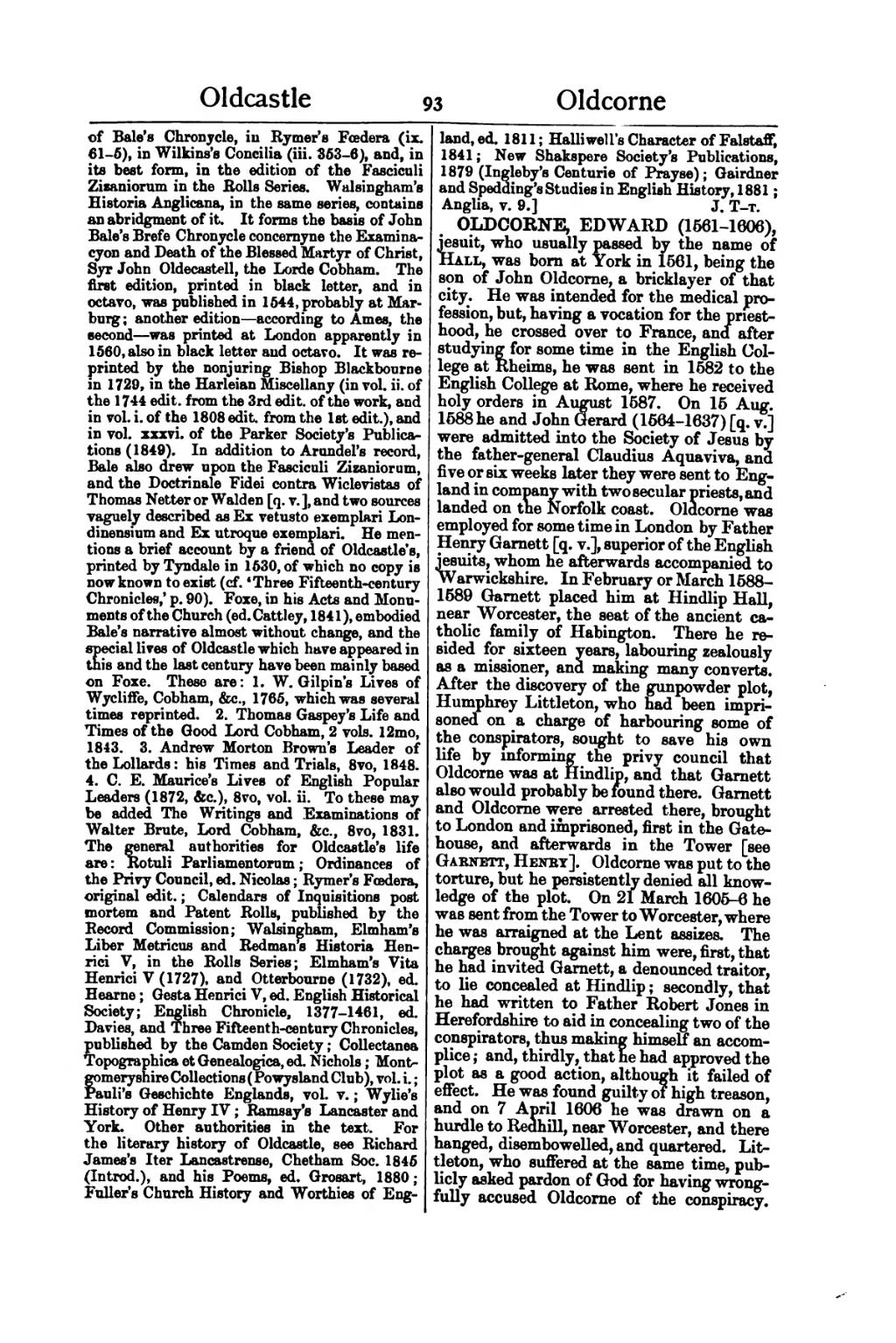OLDCORNE, EDWARD (1561–1606), jesuit, who usually passed by the name of Hall, was born at York in 1561, being the son of John Oldcorne, a bricklayer of that city. He was intended for the medical profession, but, having a vocation for the priesthood, he crossed over to France, and after studying for some time is the English College at Rheims, he was sent in 1582 to the English College at Rome, where he received holy orders in August 1587. On 16 Aug. 1588 he and John Gerard (1564-1637) [q. v.] were admitted into the Society of Jesus by the father-general Claudius Aquaviva, and five or six weeks later they were sent to England in company with two secular priests, and landed on the Norfolk coast. Oldcorne was employed for some time in London by Father Henry Garnett [q. v.], superior of the English Jesuits, whom he afterwards accompanied to Warwickshire. In February or March 1588-1589 Garnett placed him at Hindlip Hall, near Worcester, the seat of the ancient catholic family of Habington. There he resided for sixteen years, labouring jealously as a missioner, and making many converts. After the discovery of the gunpowder plot, Humphrey Littleton, who had been imprisoned on a charge of harbouring some of the conspirators, sought to save his own life by informing the privy council that Oldcorne was at Hindlip, and that Garnett also would probably he found there. Garnett and Oldcorne were arrested there, brought to London and imprisoned, first in the Gatehouse, and afterwards in the Tower [see Garnett, Henry]. Oldcorne was put to the torture, but he persistently denied all knowledge of the plot. On 21 March 1605-6 he was sent from the Tower to Worcester, where he was arraigned at the Lent assizes. The charges brought against him were, first, that he had invited Garnett, a denounced traitor, to lie concealed at Hindlip; secondly, that he had written to Father Robert Jones in Herefordshire to aid in concealing two of the conspirators, thus making himself an accomplice; and, thirdly, that he had approved the plot as a good action, although it failed of effect. He was found guilty of high treason, and on 7 April 1606 he was drawn on a hurdle to Redhill, near Worcester, and there hanged, disembowelled, and quartered. Littleton, who suffered at the same time, publicly asked pardon of God for having wrongfully accused Oldcorne of the conspiracy.
Page:Dictionary of National Biography volume 42.djvu/99
Jump to navigation
Jump to search
Oldcastle
93
Oldcorne
of Bale's Chronycle, in Rymer's Fœdera (ix. 61–5), in Wilkins's Concilia (iii. 353–6), and, in its best form, in the edition of the Fasciculi Zizaniorum in the Rolls Series. Walsingham's Historia Anglicana, in the same series, contains an abridgment of it. It forms the basis of John Bale's Brefe Chronycle concernyne the Examinacyon and Death of the Blessed Martyr of Christ, Syr John Oldecastell, the Lorde Cobham. The first edition, printed in black letter, and in octavo, was published in 1544, probably at Marburg; another edition—according to Ames, the second—was printed at London apparently in 1560, also in black letter and octavo. It was reprinted by the nonjuring Bishop Blackbourne in 1729, in the Harleian Miscellany (in vol. ii. of the 1744 edit. from the 3rd edit. of the work, and in vol. i. of the 1808 edit. from the 1st edit.), and in vol. xxxvi. of the Parker Society's Publications (1849). In addition to Arundel's record, Bale also drew upon the Fasciculi Zizaniorum, and the Doctrinale Fidei contra Wiclevistas of Thomas Netter or Walden [q.v.] , and two sources vaguely described as Ex vetusto exemplari Londinensium and Ex utroque exemplari. He mentions a brief account by a friend of Oldcastle's, printed by Tyndale in 1530, of which no copy is now known to exist (cf. ‘Three Fifteenth-century Chronicles,’ p. 90). Foxe, in his Acts and Monuments of the Church (ed. Cattley, 1841), embodied Bale's narrative almost without change, and the special lives of Oldcastle which have appeared in this and the last century have been mainly based on Foxe. These are: 1. W. Gilpin's Lives of Wycliffe, Cobham, &c., 1765, which was several times reprinted. 2. Thomas Gaspey's Life and Times of the Good Lord Cobham, 2 vols. 12mo, 1843. 3. Andrew Morton Brown's Leader of the Lollards: his Times and Trials, 8vo, 1848. 4. C. E. Maurice's Lives of English Popular Leaders (1872, &c.), 8vo, vol. ii. To these may be added The Writings and Examinations of Walter Brute, Lord Cobham, &c., 8vo, 1831. The general authorities for Oldcastle's life are: Rotuli Parliamentorum; Ordinances of the Privy Council, ed. Nicolas; Rymer's Fœdera, original edit.; Calendars of Inquisitions post mortem and Patent Rolls, published by the Record Commission; Walsingham, Elmham's Liber Metricus and Redman's Historia Henrici V, in the Rolls Series; Elmham's Vita Henrici V (1727), and Otterbourne (1732), ed. Hearne; Gesta Henrici V, ed. English Historical Society; English Chronicle, 1377–1461, ed. Davies, and Three Fifteenth-century Chronicles, published by the Camden Society; Collectanea Topographica et Genealogica, ed. Nichols; Montgomeryshire Collections (Powysland Club), vol. i.; Pauli's Geschichte Englands, vol. v.; Wylie's History of Henry IV; Ramsay's Lancaster and York. Other authorities in the text. For the literary history of Oldcastle, see Richard James's Iter Lancastrense, Chetham Soc. 1845 (Introd.), and his Poems, ed. Grosart, 1880; Fuller's Church History and Worthies of England, ed. 1811; Halliwell's Character of Falstaff, 1841; New Shakspere Society's Publications, 1879 (Ingleby's Centurie of Prayse); Gairdner and Spedding's Studies in English History, 1881; Anglia, v. 9.]
